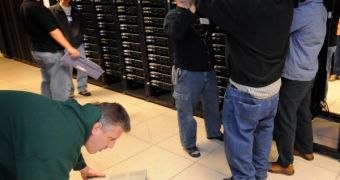Supercomputers are complex and intricate creatures with racks linked by kilometers of optical fiber. Most of such computing behemoths are extremely difficult to deploy and sometimes it takes full months between shipping and the first boot-up. The Purdue University supercomputer is a rare case, given the fact that it was deployed in less than six hours.
The university's IT department initially estimated that it would finish assembling the computing nodes in just a day. The whole process started yesterday morning, and the supercomputer was already operational by lunch time.
"The assembly was finished much faster than we expected, and by noon we were doing science", says Gerry McCartney, vice president for information technology and chief information officer. "The staff was enthusiastic, the weather was great, and there were no problems installing the hardware or software. There is no cloud to accompany this silver lining", he continued.
According to the university, more than 500 of the whole 812 nodes were up and running 1,400 research jobs by 1 p.m. The Steele supercomputer is comprised of 812 Dell servers and can reach a total computing power of 60 trillion operations per second. Judging by its computing power, the system ranks 40th in the Top 100 Supercomputers list but it is the largest machine of its kind in the Big Ten campus.
"We discovered that a build like this leverages the commodity nature of cluster computing, by using standard computing parts", McCartney said. "By using commodity computer servers to build our supercomputer, we didn't have to fly in engineers or hire specialized technicians. We were able to do it with our own IT staff in about four hours", he continued.
The Steele supercomputer was bought by the Purdue faculty members who chose to donate the research funds rather than use them for purchasing additional research gear for their own laboratories.

 14 DAY TRIAL //
14 DAY TRIAL //